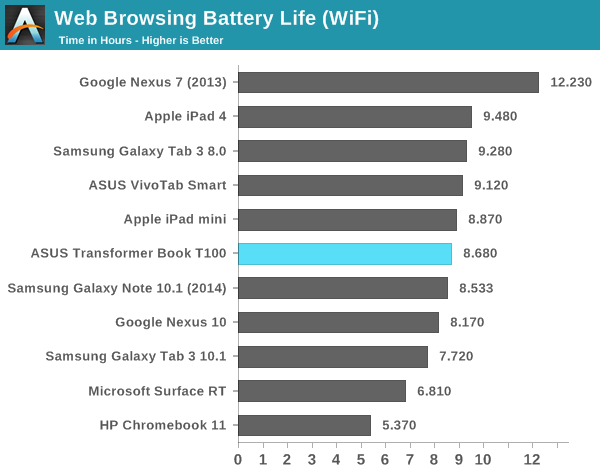ASUS Transformer Book T100 Review: Redefining the Entry-Level Windows Notebook
by Anand Lal Shimpi on October 18, 2013 12:00 AM ESTBattery Life
The Transformer Book T100 features an integrated 31Wh battery. As the keyboard dock doesn’t include an extra battery, that’s all you get. The good news is that Intel’s Atom Z3740 is built on the company’s first 22nm SoC process and it’s paired with LPDDR3. At least on the silicon front, the T100 should be fairly power efficient. Granted there are still the PMIC, display, WiFi and other components to worry about, but here’s to hoping ASUS did a reasonable job there as well.
Unfortunately ASUS delivered our T100 review sample less than 48 hours ago and I’ve been using it non-stop since then. I think I technically broke embargo by using it at a press event but it’s the only way I’d get enough time with the thing under my belt to feel comfortable writing about it. The bad news is that I only had enough time to provide a battery life teaser. I’m still running more data but for now all I’ve got is our WiFi web browsing test.
The T100’s results are presented with the keyboard dock attached and with the display calibrated to 200 nits:

Battery life looks decent at just over 8.5 hours on a single charge. In practice I had no complaints about battery life while using the device. It feels more like a tablet in that regard and less like a notebook, which is a good thing. Once again we’re seeing ASUS redefining what we’ve come to expect from an entry level notebook PC here. Even compared to Chromebooks we see the T100 do extremely well. I’m curious to get a better feel for how Bay Trail performs in the battery life department, which I’ll be doing over the coming days. So far the results look good but not quite stellar if you compare it to traditional Android/iOS tablets. I am curious to see how BT running Android would turn out.










158 Comments
View All Comments
axien86 - Friday, October 18, 2013 - link
The pricing of the Asus T100 with 10" display in a toylike "plasticky" case priced around $400 for only 2GB of memory and no SATA drive capability shows how limited options OEMs have with Baytrail Atoms. It loses especially badly in graphics to a quad core Kabini.By comparison, the Toshiba Satellite 15.6 Touchscreen C55DT-A5307 sells for $399.99 and comes with quad core A6-5200 Kabini, 4GB memory and 500GB drive. Users can upgrade to more memory and SSD drives. By any comparison, it is a much better value and provides overall great PC user experience versus limited Asus T100 for the same price.
http://www.bestbuy.com/site/toshiba-satellite-15-6...
fokka - Friday, October 18, 2013 - link
you are comparing two completely different machines.Hubb1e - Friday, October 18, 2013 - link
A 15.6" laptop meets a completely different use case than a 10" tablet hybrid. The Tablet is a portable consumption machine that can do some work in a pinch. A 15.6" laptop is a work / play machine that can be portable. I don't see shoppers really cross shopping the two. I see people with both.Friendly0Fire - Saturday, October 19, 2013 - link
Plus, with stuff like a TN display (of the same resolution but 5" larger, no less!) and a mechanical hard drive, the user experience most likely suffers. You're trading size for cheapness.nushydude - Wednesday, November 6, 2013 - link
Can you tell us how the factory restore works? Is there a proprietory backup software? Or does it use Windows Refresh? How do you refresh it if you cannot boot into Windows? Is there a special key combination that would cause it to enter the recovery mode when pressed? Can you completely remove the recovery partition from the drives and make a USB recovery drive in case you are going for the 32GB model?Tams80 - Saturday, October 19, 2013 - link
http://globalsp.ts.fujitsu.com/dmsp/Publications/p...This might be of interest to you. You'll be paying far more than $10 extra though.
timon_comment - Saturday, October 19, 2013 - link
Waiting a look in Bay Trail M + SATA,in Windows x86 OS I dislike the eMMC storage system, it is an execrable design, the heavyweight Windows x86 OS is fully unlike in the lightweight Android OS, Windows needs SATA and PCIe, but Atom Bay Trail T is still no support SATA and PCIe.
Intel actually wanted in Android to compete with ARM processor, does not really want Bay Trail T to help Windows tablet to compete market, because the x86 processor is almost no another competitor! Now is Intel wanted to control the Android market!
lmcd - Sunday, October 20, 2013 - link
Would've been great to up the price by $15 for that, or $25 for that and RAM. Then good margins still, but good benefit for consumers.tinaaa - Monday, October 21, 2013 - link
The Z3770 is probably similar in battery life/size/cost/weight. I'm guessing price points was the key. It would have been nice to offer the 64GB version with the upgraded CPU.stanwood - Monday, October 21, 2013 - link
It may be the case that Intel could not supply the Z3770 in sufficient volumes. This is often true for the top-range part number early in a design's life cycle.